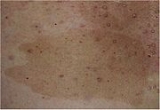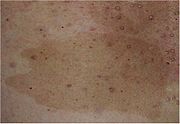
Café au lait spot
Encyclopedia
Café au lait spots or Café au lait macules are pigmented birthmark
s. The name café au lait
is French
for "milky coffee" and refers to their light-brown color. They are also called "giraffe spots."
 Café au lait spots can arise from diverse and unrelated causes:
Café au lait spots can arise from diverse and unrelated causes:
.
Birthmark
A birthmark is a benign irregularity on the skin which is present at birth or appears shortly after birth, usually in the first month. They can occur anywhere on the skin. Birthmarks are caused by overgrowth of blood vessels, melanocytes, smooth muscle, fat, fibroblasts, or...
s. The name café au lait
Café au lait
Café au lait is a French coffee drink. The meaning of the term differs between Europe and the United States; in both cases it means some kind of coffee with hot milk added, in contrast to white coffee, which is coffee with room temperature milk or other whitener added.- Europe :In Europe, "café au...
is French
French language
French is a Romance language spoken as a first language in France, the Romandy region in Switzerland, Wallonia and Brussels in Belgium, Monaco, the regions of Quebec and Acadia in Canada, and by various communities elsewhere. Second-language speakers of French are distributed throughout many parts...
for "milky coffee" and refers to their light-brown color. They are also called "giraffe spots."
Etiology

- Having six or more café au lait spots greater than 5 mm in diameter before puberty, or greater than 15 mm in diameter after puberty, is a diagnostic feature of neurofibromatosis type INeurofibromatosis type INeurofibromatosis type I , formerly known as von Recklinghausen disease after the researcher who first documented the disorder, is a human genetic disorder. It is possibly the most common inherited disorder caused by a single gene...
, but other features are required to diagnose NF-1. - Familial multiple café au lait spots have been observed without NF-1 diagnosis..
- They can be caused by vitiligoVitiligoVitiligo is a condition that causes depigmentation of sections of skin. It occurs when melanocytes, the cells responsible for skin pigmentation, die or are unable to function. The cause of vitiligo is unknown, but research suggests that it may arise from autoimmune, genetic, oxidative stress,...
in the rare McCune-Albright syndromeMcCune-Albright syndromeMcCune–Albright syndrome, described in 1937 by Donovan James McCune and Fuller Albright, is a genetic disorder of bones, skin pigmentation and hormonal problems along with premature puberty.-Symptoms:...
. - Legius syndromeLegius syndromeLegius syndrome is an autosomal dominant condition characterized by cafe au lait spots. It is often mistaken for Neurofibromatosis type I . It is caused by mutations in the SPRED1 gene. It is also known as Neurofibromatosis Type 1-like syndrome .The syndrome is named after Eric Legius,...
- Tuberous sclerosisTuberous sclerosisTuberous sclerosis or tuberous sclerosis complex is a rare multi-system genetic disease that causes non-malignant tumors to grow in the brain and on other vital organs such as the kidneys, heart, eyes, lungs, and skin. A combination of symptoms may include seizures, developmental delay, behavioral...
- Fanconi anemiaFanconi anemiaFanconi anemia is a genetic disease with an incidence of 1 per 350,000 births, with a higher frequency in Ashkenazi Jews and Afrikaners in South Africa.FA is the result of a genetic defect in a cluster of proteins responsible for DNA repair...
, a rare genetic disease. - IdiopathicIdiopathicIdiopathic is an adjective used primarily in medicine meaning arising spontaneously or from an obscure or unknown cause. From Greek ἴδιος, idios + πάθος, pathos , it means approximately "a disease of its own kind". It is technically a term from nosology, the classification of disease...
- Ataxia telangiectasiaAtaxia telangiectasiaAtaxia telangiectasia is a rare, neurodegenerative, inherited disease that affects many parts of the body and causes severe disability. Ataxia refers to poor coordination and telangiectasia to small dilated blood vessels, both of which are hallmarks of the disease...
- Basal cell nevus syndrome
- Benign congenital skin lesion
- Bloom syndromeBloom syndromeBloom's syndrome , also known as Bloom–Torre–Machacek syndrome, is a rare autosomal recessive chromosomal disorder characterized by a high frequency of breaks and rearrangements in an affected person's chromosomes. The condition was discovered and first described by dermatologist Dr...
- Chediak Higashi syndrome
- Congenital naevus
- Gaucher disease
- Hunter syndromeHunter syndromeHunter syndrome, or mucopolysaccharidosis Type II, is a lysosomal storage disease caused by a deficient enzyme, iduronate-2-sulfatase . The syndrome is named after physician Charles A. Hunter , who first described it in 1917...
- Maffucci syndrome
- Multiple mucosal neuroma syndrome
- Russell-Silver syndrome
- Watson syndromeWatson syndromeWatson syndrome is an autosomal recessive condition characterized by Lisch nodules, axillary/inguinal freckling, and neurofibromas.Watson syndrome may be allelic to NF1, the same gene associated with Neurofibromatosis type 1.- References :...
- Wiskott-Aldrich syndromeWiskott-Aldrich syndromeWiskott–Aldrich syndrome is a rare X-linked recessive disease characterized by eczema, thrombocytopenia , immune deficiency, and bloody diarrhea . It is also sometimes called the eczema-thrombocytopenia-immunodeficiency syndrome in keeping with Aldrich's original description in 1954...
Diagnosis
Diagnosis is visual with measurement of spot size and count of number of spots having clinical significance for diagnosis of associated disorders such as Neurofibromatosis type INeurofibromatosis type I
Neurofibromatosis type I , formerly known as von Recklinghausen disease after the researcher who first documented the disorder, is a human genetic disorder. It is possibly the most common inherited disorder caused by a single gene...
.

